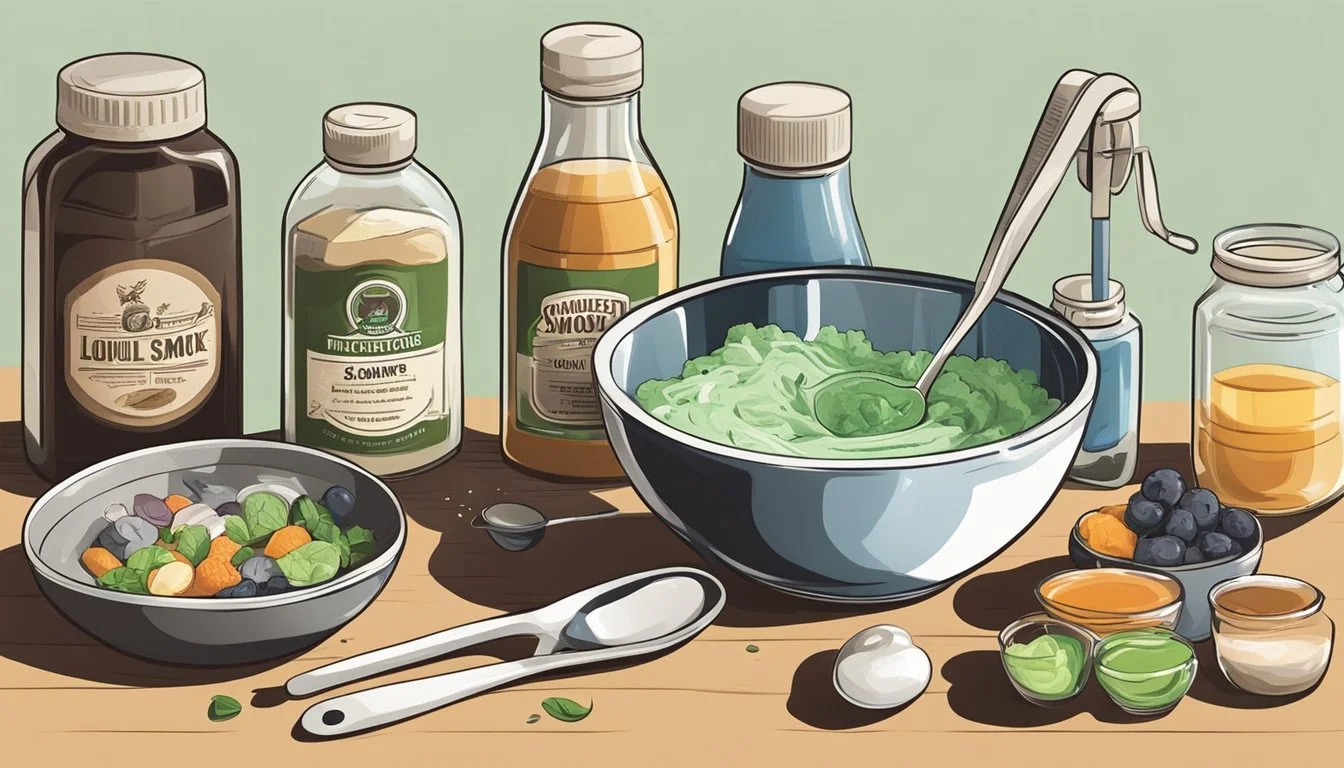Liquid Smoke Substitutes
Top Alternatives for Smoky Flavors
Liquid smoke is a popular flavoring used to impart a smoky taste to foods without the need for actual smoking equipment or the lengthy process of smoking. It's highly concentrated and derived from smoldering wood chips, which capture the essence of the smoke in liquid form. This seasoning is sought after for its ability to easily add depth and a savory, smoky nuance to various dishes, from meats and marinades to soups and stews (What wine goes well with stews?). However, due to dietary preferences, availability, or a desire for a different flavor profile, cooks may find themselves in need of a substitute for liquid smoke.
Various alternatives can deliver the desired smoky flavor that liquid smoke provides. Smoked paprika stands out as a prominent substitute. It is made by smoking, drying, and grinding specific varieties of peppers, giving dishes a similar depth of smoky taste with an additional color and mild heat. Smoked salt is another option and can be used in place of regular salt in recipes to introduce a subtle smoked flavor that mimics that of liquid smoke. These substitutes not only cater to the need for a smoky taste but also add their unique touches to dishes, allowing cooks to customize the flavor according to their preferences and the culinary direction they wish to take.
Understanding Liquid Smoke
Liquid smoke captures the essence of smokehouse flavors, offering a condensed smoke experience that can be easily added to a variety of dishes. This section delves into its origins, culinary applications, and dietary implications.
Origins and Production
Liquid smoke is produced through the condensation of smoke from burning wood chips, commonly hickory, mesquite, or applewood. The smoke is filtered to remove particulates and tar, then condensed into the liquid form. Wood chips and sometimes charcoal are essential in creating the nuanced smoke flavor profiles that liquid smoke imparts to food.
Common Uses in Cooking
Chefs and home cooks use liquid smoke primarily to impart a smoke flavor to meats, vegetables, sauces, soups, and stews without the need for a smokehouse or grilling over wood chips. Liquid smoke is versatile, capable of mimicking the taste of various smoked meats and adding depth to dishes that traditionally require slow cooking over low heat, such as barbecue inspired recipes.
Meats: Enhances flavor profiles similar to smoked meats.
Vegetables: Adds a smoked touch to grilled or roasted veggies.
Sauces/Desserts: Brings complexity to BBQ sauces or unexpected smokiness to certain desserts.
Health and Dietary Considerations
Liquid smoke can be a part of a balanced diet but should be used in moderation. Some brands may contain additives or preservatives, so those with dietary restrictions should read labels carefully. Smoked salt is an alternative that can be used to achieve a similar flavor while maintaining control over smoke intensity and sodium intake.
Liquid Smoke Substitutes
When seeking alternatives to liquid smoke for imparting a smoky flavor to recipes, there are several options ranging from spices and concentrates to smoking tools and techniques. These substitutes provide a variety of flavors and can be used in different cooking applications.
Smoked Paprika
Smoked paprika, often referred to as Spanish paprika, acts as an excellent stand-in for liquid smoke. It provides a distinct smoky taste and a rich red color, ideal for adding both flavor and visual appeal to a dish. One can substitute a teaspoon of liquid smoke with half a teaspoon of smoked paprika to achieve the desired smokiness in a recipe.
Chipotle-Based Options
Chipotle peppers, either dry as chipotle powder or canned in adobo sauce, impart a smoky heat to dishes. The adobo sauce used with canned chipotle peppers also contains a blend of spices that can enhance the overall flavor profile. When replacing liquid smoke, use these chipotle-based options judiciously to manage the spice level in the recipe.
Wood Chips and Smoke Gun
For those who prefer a more hands-on approach, wood chips used in conjunction with a smoker or smoke gun can create a custom smoke-infused flavor. Different types of wood, such as hickory or applewood, provide varying flavors. This method requires more time and equipment but allows for greater control over the intensity of the smoke flavor.
Herbal and Tea Infusions
Lapsang Souchong, also known as smoked tea, is a unique alternative with its naturally smokey flavor. It can be steeped and used as a liquid infusion in recipes that call for liquid smoke. This option is ideal for those looking for a subtle smokiness without any additional heat.
Concentrates and Powders
Concentrated flavoring agents, like hickory smoke powder, offer a potent substitute for liquid smoke. Because of their concentrated nature, they should be used sparingly to prevent the smoke flavor from overpowering the dish. These powders are easily blended into marinades, rubs, and sauces to achieve a smoky flavoring similar to liquid smoke.
Implementing Substitutes in Recipes
When seeking to replicate the savory depth that liquid smoke imparts in dishes, one should consider the potency and flavor nuances of available substitutes. It's crucial to balance the essence of smoke while ensuring the substitute harmonizes with other ingredients.
Adjusting Flavor Intensity
To adjust the intensity of smoke flavor, it’s important to experiment with substitution ratios. Smoked paprika typically requires a one-to-one substitution for liquid smoke, but may be tailored according to the desired smokiness. Chipotle powder imparts a more intense heat and should be used more sparingly, often at half the quantity of liquid smoke called for in the recipe. When incorporating substitutes in marinades, begin with a conservative amount and adjust based on taste preference to avoid overpowering the primary flavors of the meat.
Substitutes for Specific Dishes
Different dishes benefit from specific smoke-flavored seasonings. For meats, chefs might opt for smoked salts or smoked paprika to add a delicate smoky touch. In soups and stews, ingredients like smoked ham hocks or bacon can infuse depth of flavor naturally. Here's a quick guide on what to use:
Meats: Smoked sea salt, smoked paprika
Vegetable Dishes: Smoked olive oil, chipotle powder
Soups and Stews: Bacon, smoked ham hocks
Cocktails: A drop of homemade liquid smoke, or a smoked glass rim
Breads: Incorporate smoked flour for a subtle smoked essence
Remember to introduce the substitute at the same cooking stage the liquid smoke would typically be added to ensure even distribution of flavor.
DIY Smoke Flavorings
For those inclined towards a homemade approach, creating a DIY liquid smoke is achievable. One can simmer ingredients like smoked tea leaves, hickory bark, or even charred wood chips in water to create a water-soluble smoke flavoring. This extract should be used sparingly, as it can be quite potent. For a makeshift smoke machine, infuse smoke into a cocktail by trapping it under a glass inverted over a smoking wood chip, imparting a unique twist to the drink. When crafting these DIY smoke flavorings, chefs maintain complete control over the intensity and essence of the smoke, achieving a tailor-made seasoning that complements their culinary creations precisely.
Additional Flavor Enhancers and Techniques
When seeking alternatives to liquid smoke, one can find an array of flavor enhancers and techniques that impart a savory or smoky taste to dishes. These can be used individually or in combination to achieve a complex flavor profile.
Savory Additions
Smoked Salt stands out among savory flavor enhancers, delivering a smoky taste without overpowering dishes. It can be used in marinades or sprinkled onto food before cooking. Worcestershire Sauce offers a complex flavor with tangy, sweet, and salty notes, which can serve as a liquid smoke alternative, especially in meat-based preparations.
Smoked Salt: Apply in moderation to avoid excess saltiness.
Worcestershire Sauce: Ideal for marinades and sauces to impart a deep umami quality.
Sweet and Bitter Profiles
In terms of building a sweet and slightly bitter profile, ingredients like Sugar and Beer work well. Sugar, when caramelized, can create a complex flavor base that pairs exceptionally well with smoky seasonings in a Dry Rub. On the other hand, Beer can be used to braise meats or as a base in stews, introducing both a subtle bitterness and the slight sweetness of malt, which mimics some of the undertones found in smoked foods.
Sugar: Use in a dry rub mixed with paprika or chili powder to balance the sweetness.
Beer: Opt for darker ales or stouts for a richer flavor.
Frequently Asked Questions
When seeking to replace liquid smoke in a recipe, one may wonder about the best substitutes that can deliver a similar flavor profile. The right choice depends on the dish being prepared and desired smokiness intensity.
Choosing the Right Substitute
Selecting an appropriate liquid smoke substitute is crucial to achieve the desired smokiness in a dish without altering its fundamental taste. Here are some specific substitutes:
Smoked Paprika: This spice offers a smoky flavor and is great for marinades, rubs, and stews.
Chipotle Powder: With its smoky and slightly spicy taste, chipotle powder works well in Mexican-inspired dishes.
Smoked Salt: Enhances the dish with a subtle smokiness, suitable for almost all recipes requiring liquid smoke.
Smoked Meats: Incorporating smoked meats like ham or turkey can infuse the dish with a profound smoky essence.
Smoked Tea (Lapsang Souchong): Offers an exotic smoke flavor, ideal for sauces and marinades.
One must consider the recipe and the intensity of smokiness while choosing a substitute. For a stronger flavor, chipotle powder or smoked meats could be preferred options. For subtler notes, smoked paprika or smoked salt might be more suitable. Each substitute provides different levels of smokiness and additional flavors; therefore, one should start with a small amount and adjust according to taste. Remember, the aim is to complement the main ingredients, not to overpower them.






